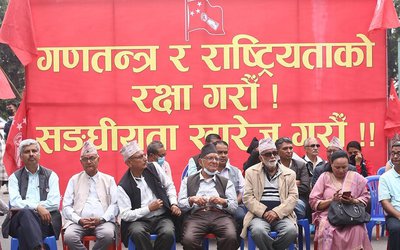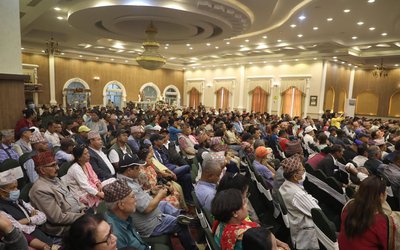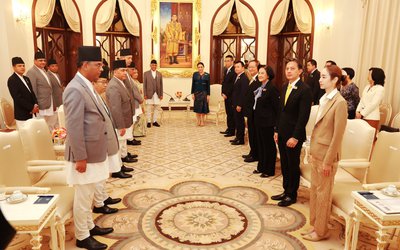More on News






The already fraught China-India relationship appears headed for more turbulent times as a result of the two giants' failure to make progress on resolving any of the issues that divide them. Earlier this month, during the first visit in more than four years of a Chinese leader to India, the two sides decided to kick all contentious issues down the road. Instead, Premier Wen Jiabao and Prime Minister Manmohan
Singh agreed to expand bilateral trade by two-thirds over the next five years.
But the trade relationship is anything but flattering for India, which is largely exporting primary commodities to China and importing finished products, as if it were the raw-material appendage of a
neocolonial Chinese economy. To make matters worse, India confronts a ballooning trade deficit with China and the dumping of Chinese goods that is systematically killing local manufacturing.
The focus on trade even as political disputes fester only plays into the Chinese agenda to gain bigger commercial benefits in India while being free to inflict greater strategic wounds on that country.
India-China relations have entered a particularly frosty spell, with New Delhi's warming relationship with Washington emboldening Beijing to up the ante through border provocations, resurrection of its
long-dormant claim to the northeastern Indian state of Arunachal Pradesh, and diplomatic needling. After initially seeking greater cooperation to help dissuade New Delhi from moving closer to the U.S., Beijing shifted to a more-coercive approach following the mid-2005 U.S.-India defense framework agreement and nuclear deal.
Last year relations sank to their lowest political point in more than two decades when Beijing unleashed a psychological war, employing its state-run media and nationalistic Web sites to warn of another armed
conflict. The coarse rhetoric of the period leading up to the 1962 Chinese military attack also returned, with the Chinese Communist Party's broadsheet, People's Daily, for example, berating India for "recklessness and arrogance" and asking it to weigh "the consequences of a potential confrontation with China."
Since then, Beijing has picked territorial fights with other neighbors as well, kindling fears of an expansionist China across Asia.The only area where India-China relations have thrived is commerce. But the rapidly growing trade, far from helping to turn the page on old rifts, has been accompanied by greater Sino-Indian geopolitical rivalry and military tensions, resulting in India beefing up defenses. Tibet remains at the core of the Sino-Indian divide. While Chinese damming of international rivers has helped link water with land disputes, the 30-year-long negotiations to settle territorial feuds have hit a wall and gone off on a tangent.
Little surprise a 20-fold increase in trade in the past decade to $60 billion has yielded a more muscular Chinese policy. In fact, the more China's trade surplus with India has swelled — jumping from $2 billion
in 2002 to almost $20 billion this year — the greater has been its condescension toward India.
Trade in today's market-driven world is not constrained by political disputes or even strained ties, unless artificial political barriers have been erected, such as through sanctions. The China-India relations actually demonstrate that booming trade is no guarantee of moderation or restraint between states. Unless estranged neighbors fix their political relations, economics alone will not be enough to create good will or stabilize their relationship.
Yet ignoring that lesson, China and India have left their political rows to future diplomacy to clear up, with Wen bluntly stating that sorting out the border disputes "will take a fairly long period of time." On the eve of his visit, Zhang Yan, the Chinese ambassador to India, publicly acknowledged that, "China-India relations are very fragile and very easy to be damaged and very difficult to repair."
Even as old rifts remain, new issues are roiling relations, including Chinese strategic projects and military presence in Pakistani-held Kashmir and a new policy by China (which occupies one-fifth of the original princely state of Jammu and Kashmir) to depict the Indian-administered portion of that state as de facto independent. It thus has been issuing visas to residents there on a separate leaf, not on their Indian passport. It also has stopped counting its 1,600-km border with Indian Kashmir as part of the frontier it shares with India.
In less than five years, China has gone from reviving the Arunachal Pradesh card to honing the Kashmir card against India. Thanks to China's growing strategic footprint in Pakistani-held Kashmir, India now faces Chinese troops on both flanks of its portion of Kashmir. Indeed, the deepening China-Pakistan nexus presents India with a two-front theater in the event of a war with either country.
China is unwilling to accept the territorial status quo, or enter into a river waters-sharing treaty as India has done with downriver Bangladesh and Pakistan. Yet it wants to focus relations increasingly on commerce, even pushing for a free-trade agreement. With the Western and Japanese markets racked by economic troubles, the Chinese export juggernaut needs a larger market share in India, the world's second fastest-growing economy.
But the current lopsided trade pattern — presenting a rising India as an African-style raw material source — is just not sustainable. China's proven iron-ore deposits, according to various international estimates, are more than 2 1/2 times that of India. Yet China is conserving its own reserves and importing iron ore in a major way from India, to which, in return, it exports value-added steel products. As India ramps up its own steel-producing capacity over the next five years, China will have dwindling access to Indian iron ore.
At present, China maintains nontrade barriers and other mechanisms that keep out higher-value Indian exports, such as information technology and pharmaceutical products; it exports to India double of
what it imports in value; it continues to blithely undercut Indian manufacturing despite a record number of antidumping cases against it by India in the World Trade Organization; and its foreign direct investment in India is so minuscule ($52 million in the past decade) as to be undetectable.
Such ties amount to lose-lose for India and win-win for China. As if to underline that such unequal commerce cannot override political concerns, India has refused to reaffirm its support for Beijing's sovereignty over Tibet and Taiwan. India had been periodically renewing its commitment to a "one China" policy, even as Beijing not only declined to make a reciprocal one-India pledge. But in a sign of the growing strains in ties, Wen left for his country's "all-weather" ally, Pakistan, with a joint communique in which India's one-China commitment was conspicuously missing.





